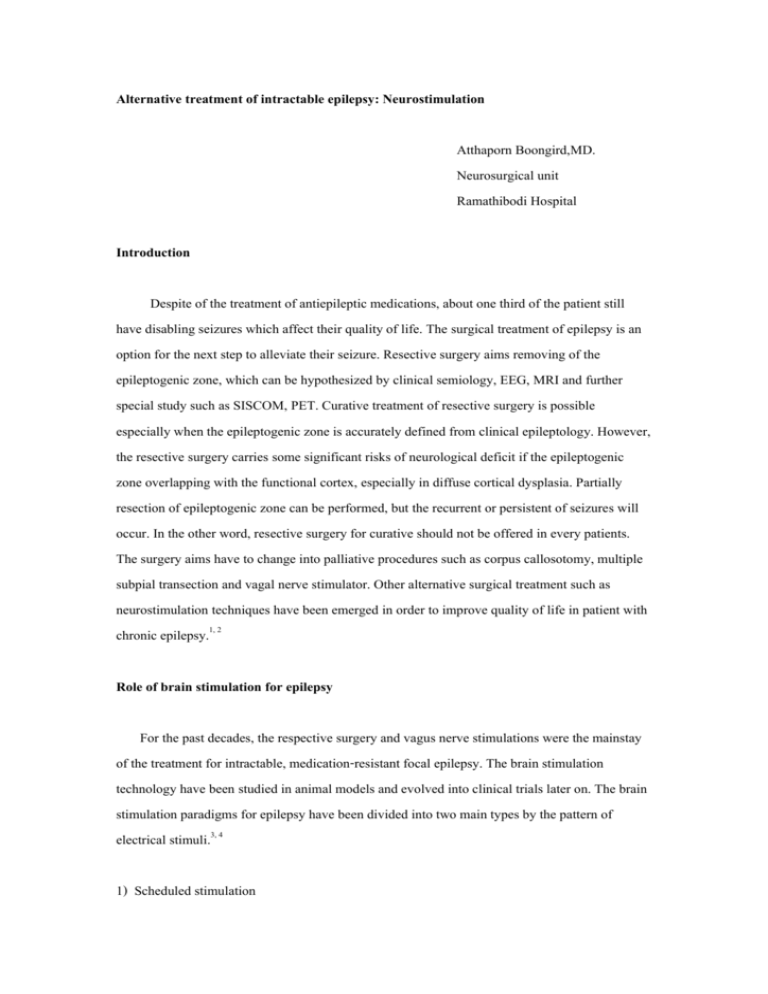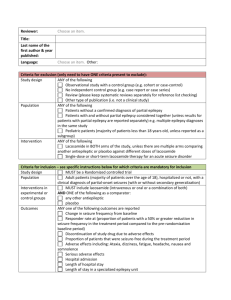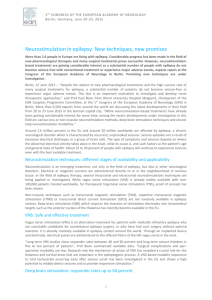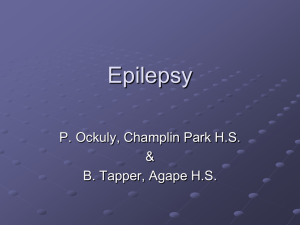Alternative-treatment-of-intractable
advertisement

Alternative treatment of intractable epilepsy: Neurostimulation Atthaporn Boongird,MD. Neurosurgical unit Ramathibodi Hospital Introduction Despite of the treatment of antiepileptic medications, about one third of the patient still have disabling seizures which affect their quality of life. The surgical treatment of epilepsy is an option for the next step to alleviate their seizure. Resective surgery aims removing of the epileptogenic zone, which can be hypothesized by clinical semiology, EEG, MRI and further special study such as SISCOM, PET. Curative treatment of resective surgery is possible especially when the epileptogenic zone is accurately defined from clinical epileptology. However, the resective surgery carries some significant risks of neurological deficit if the epileptogenic zone overlapping with the functional cortex, especially in diffuse cortical dysplasia. Partially resection of epileptogenic zone can be performed, but the recurrent or persistent of seizures will occur. In the other word, resective surgery for curative should not be offered in every patients. The surgery aims have to change into palliative procedures such as corpus callosotomy, multiple subpial transection and vagal nerve stimulator. Other alternative surgical treatment such as neurostimulation techniques have been emerged in order to improve quality of life in patient with chronic epilepsy.1, 2 Role of brain stimulation for epilepsy For the past decades, the respective surgery and vagus nerve stimulations were the mainstay of the treatment for intractable, medication-resistant focal epilepsy. The brain stimulation technology have been studied in animal models and evolved into clinical trials later on. The brain stimulation paradigms for epilepsy have been divided into two main types by the pattern of electrical stimuli.3, 4 1) Scheduled stimulation The electrical stimulation is given via commercially available neurostimulators, which was implanted in the chest wall and connected to the targeted electrodes such as left vagal nerve, anterior thalamic nuclei, hippocampi. The scheduled stimulation is hypothesized to alter the intrinsic neurophysiologic properties of epileptic networks, which subsequently increases the seizure threshold. The targeted area can be in any part of the circuit of epilepsy network, which can be reached by surgery without major risks of complications. 1.1) Stimulation of the anterior nucleus of the thalamus The anterior nucleus of thalamus is part of the circuit of Papez. Its complex anatomy of this nucleus is divided into 4 parts, Apr (main), AM(medial),AD(dorsal) and DSF(superficial). The Apr part are the main principle nucleus, which is about 4*5*10mm3 in dimension. The input of ANT mainly arises from hippocampus, fornix and mammillothalamic tract respectively. The output of ANT goes to cingulum and paralimblic structures to complete the circuit of Papez. The boundary of ANT is also important for direct targeting this small nucleus. The ventricular system serves as the boarder anteriorly and superiorly. The mammillothalamic tract ran into this nucleus inferiorly in coronal and sagittal plane. The lateral boundary seperates from other thalamic nucleus by internal laminae. Imaging sequence of ANT complex can be visualized from both MRI T1 and STIR (Short Tau Inversion Recovery). STIR seems to increase the contrast between grey and white matter better than T2 sequence. The most important anatomical landmark for defining ANT is the identification of mammillothalamic tract, which can be followed as a dark signal from mammillary body to ANT. The mammillothalamic tract can be easily seen in coronal and sagittal view during the planning.(Figure 1) Figure 1 demonstrated the bilateral ANT DBS trajectory planning on STIR sequence and post operative implanted electrodes in bilateral ANT on T1 sequence.(white arrows) Animal experiments of bilateral anterior nucleus of thalamus stimulation in seizure model such as kindling model, PTZ model revealed the effectiveness of seizure control.5 The stimulation of the Anterior Nucleus of the Thalamus for Epilepsy (SANTE) trial (110 patients) outcome and other retrospective data reassured the effectiveness of ANT stimulation as an option for improving seizure control and quality of life of these medically intractable epilepsy patients.6 Identifications of surgical candidate are the refractory epileptic patient with disabling seizures, which affect quality of life, secondly the epileptogenic zone cannot be safely treated by surgical resective procedures, third the patient passes the neuropsychological evaluation. Long term follow-up in 86 patients were shown, 60% had a seizure reduction of >50%. Nine percent of patients were seizure free. 1.2) Hippocampal stimulation This target aims avoiding memory deficits associated with temporal lobe surgery. The scheduled stimulation acted on the seizure onset zone. The uncontrolled studies with good responder rates have been shown by numerous authors.7, 8 CoRaStir (Prospective Randomized Controlled Study of Neurostimulation in Medial Temporal Lobe Epilepsy) and MET-TLE (Randomized Controlled Trial of Hippocampal Stimualtion for Temporal Lobe Epilepsy) are under way. 2. Responsive Stimulation The responsive stimulation directly acted on the seizure onset zone in the cortex or hippocampus. Its current has to be delivered in time ideally before the epileptiform activities propagate into seizure.9 Therefore, the seizure prediction or early detection is a prerequisite. Its rationale arising from the idea of afterdischarges (ADs) can be terminated if brief bursts of 50Hz stimulation was applied in time by Lesser.10 The first report of an implantable responsive stimulator was the RNS (Neuropace,Mountain View, CA,USA) multicenter feasibility study in three patients in American Epilepsy Society 2004. Currently, the 256 patients were implanted, the mean age of 34 years, mean number of AEDs of 2.9, and a median seizure frequency of 10.1 seizures per 28 days. After 2 years, the median percent reduction in seizure frequency was greater than 40% and the responder rate was greater than 45%.11 This current technology can targeted more than one epilepteptogenic zone and can be used on the eloquent cortex. The brief, high frequency stimuli do not interfere with cortical function. However, the limited memory capacity required the data of electrocorticography to be transferred to computer on a regular basis. The craniotomy was required for implanted device and post operative MRI could not be done. Some device-related complications were reported such as skin erosion, infection, increased seizures. Inclusion criteria Age, year Number of patients Seizures per month Failed AEDs Seizure type Design, Randomized Stimulation begun Blinded stimulation duration SANTE trial 18-65 110 More than 5 More than 3 Partial Yes 1 month post-operative 3 months RNSTM 18-70 191 >3 >2 Partial Yes 8 weeks post-operative 12 weeks Seizure frequency % change (end of blinded period) Control: -14.5% Stimulation: -40.4% Control: -14% Stimulation: -29% Responder rate (% patients with >50% seizure reduction) 43% at 13 months 54% at 25 months 67% at 37 months 45% after 2 years 53% after 3 years Seizure freedom 2 patients during blinded period Not yet published 14 patients for at least 6 months Table 1 Comparison between SANTE and RNS trials1 In conclusion, the neurostimulation techniques have been developed over decades from both animal researches and human trials. The proof of its efficacy for controlling disabling seizures and its safety for long term outcome encouraged its concept as an option for the alternative treatment of medically intractable epilepsy. The true mechanisms and neuroprotective effect of neurostimulation are ongoing investigated. The cost of device is an important issue for family member expenses. References 1. Gigante PR, Goodman RR. Alternative surgical approaches in epilepsy. Current neurology and neuroscience reports 2011;11:404-408. 2. Krishna V, Lozano AM. Brain stimulation for intractable epilepsy: Anterior thalamus and responsive stimulation. Annals of Indian Academy of Neurology 2014;17:S95-98. 3. Jobst B. Brain stimulation for surgical epilepsy. Epilepsy research 2010;89:154-161. 4. Morrell M. Brain stimulation for epilepsy: can scheduled or responsive neurostimulation stop seizures? Current opinion in neurology 2006;19:164-168. 5. Zhong XL, Lv KR, Zhang Q, et al. Low-frequency stimulation of bilateral anterior nucleus of thalamus inhibits amygdale-kindled seizures in rats. Brain research bulletin 2011;86:422-427. 6. Fisher R, Salanova V, Witt T, et al. Electrical stimulation of the anterior nucleus of thalamus for treatment of refractory epilepsy. Epilepsia 2010;51:899908. 7. Cukiert A, Cukiert CM, Burattini JA, Lima AM. Seizure outcome after hippocampal deep brain stimulation in a prospective cohort of patients with refractory temporal lobe epilepsy. Seizure : the journal of the British Epilepsy Association 2014;23:6-9. 8. Boon P, Vonck K, De Herdt V, et al. Deep brain stimulation in patients with refractory temporal lobe epilepsy. Epilepsia 2007;48:1551-1560. 9. Sun FT, Morrell MJ, Wharen RE, Jr. Responsive cortical stimulation for the treatment of epilepsy. Neurotherapeutics : the journal of the American Society for Experimental NeuroTherapeutics 2008;5:68-74. 10. Lesser RP, Kim SH, Beyderman L, et al. Brief bursts of pulse stimulation terminate afterdischarges caused by cortical stimulation. Neurology 1999;53:2073-2081. 11. Morrell MJ, Group RNSSiES. Responsive cortical stimulation for the treatment of medically intractable partial epilepsy. Neurology 2011;77:12951304.








